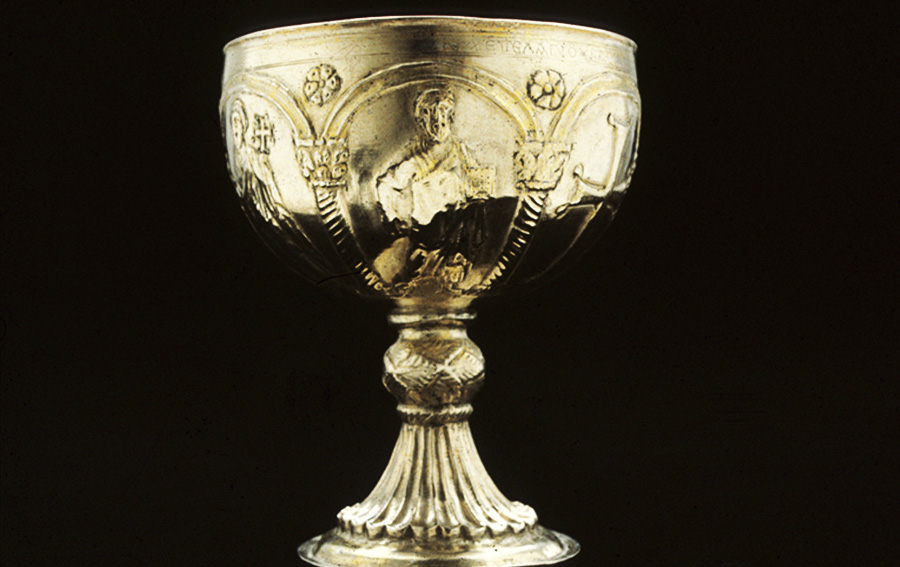
By J. Douglas Kenyon
“One of the most sacred Catholic artifacts ever,” stolen in June from a French church, has now been returned by the repentant thief. According to Britain’s The Daily Mail newspaper, a professional art detective recovered the relic, believed by the faithful, to contain actual drops of Jesus’ blood. Arthur Brand, a reputed Dutch ‘Indiana Jones,’ tracked down the object taken, along with other valuables, from a church in Fécamp. The thief, apparently fearing he was cursed for his deed, left the relic anonymously in a cardboard box outside Brand’s house. Dutch police, it is reported, are returning it to France.
When it comes to sacred relics though, the ‘holy grail’ is… well… the “Holy Grail.” And on that point, holy “blood” has different meanings for different people. In 1982 researchers Michael Baigent, Richard Lee, and Henry Lincoln argued that the real grail is actually a bloodline. That narrative from their best-selling book The Holy Blood and the Holy Grail, was later made world famous in The Da Vinci Code by novelist Dan Brown. While the former had enjoyed considerable success, it was dwarfed by the latter, which became one of the best-selling novels ever. Hollywood’s version of The DaVinci Code, directed by Ron Howard, would make big waves at the box office. To anyone familiar with the first book, it was clear that the second owed much to it. Both books claimed that Jesus was married to Mary Magdalene, with whom he fathered children, and that the resultant bloodline survives even now. Baigent, Leigh, and Lincoln took their claims to court, charging both Brown and publisher Random House with stealing their material, but the court sided with Brown.
As for the actual cup, or chalice, used by Jesus at the Last Supper and revered by early Christians: in their 2015 book, The Kings of the Grail, researchers Margarita Torres and Jose Ortega del Rio claimed that a bejeweled onyx vessel on display in Leon, Spain, is the original chalice. It has been in the basilica there since the eleventh century, and the cup’s age has been officially certified as indeed from the period 200 BC to AD 100.
It is doubtful, of course, if other potential claimants to the title of the ‘true’ Holy Grail will surrender without a fight. Many in England still believe the true grail was left by Joseph of Arimathea, in the Chalice Well at Glastonbury. Similar claims have been made for Ireland and other locations. Nazi SS head Heinrich Himmler thought an Aryan Holy Grail was to be found in Spanish Montserrat.
Grail legends of the middle ages tell us the guardian of the Holy Grail was the secretive chivalric order of the Knights Templar. Initially popularized by Wolfram von Eschenbach, himself a templar, the story of Parsifal, provided what is arguably the most comprehensive and compelling version of the grail legend. In addition to revelations regarding the templars, Eschenbach also claimed the Holy Grail could be something other than a chalice or platter (he said it was a stone), and that the original legend of the Holy Grail came not from the West but from the East. Eschenbach was emphatic on the latter point, stating that the originator of the grail legend was Flegetanis, an astrologer from the ancient middle east, Babylon perhaps, who “found it in the stars.”
In the meantime, those of a more metaphysical persuasion argue that literal interpretations often miss the real point of the grail story, that it is a symbol or archetype representing the true self of a virtuous and enlightened individual. They would maintain that the serpent in the tree in the Garden of Eden was a metaphor for kundalini energy that, serpent-like, travels up the human spine, activating spiritual centers or chakras positioned along it—the “tree of life”—before ultimately bestowing ‘gnosis’ and immortality upon him or her. Others claim the serpent was an actual human being of ancient times who taught forbidden secrets of the holy grail to humanity.
According to Templar scholar Mark Amaru Pinkham, writing in Atlantis Rising Magazine #62, “John the Baptist was part of a lineage of holy grail masters known as the Mandean Nasurai that originated in the East.” This lineage began its journey on the paradisaical island of Sri Lanka before traveling west and eventually settling on the banks of the Tigris and Euphrates Rivers in southern Iraq. For the Mandeans, Sri Lanka was the Garden of Eden, a notion that was spread by Templars, as well as some religions, like Islam, which also considered the island to be home to the “water of life” or Fountain of Youth.
Scotland’s Rosslyn Chapel, one of a few surviving templar churches, thought to hide many ancient secrets, is still identified by practicing templars as the Chapel of the Holy Grail.


















